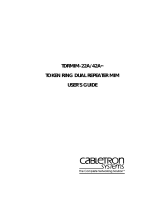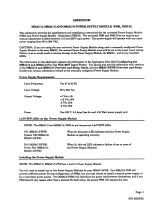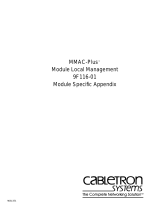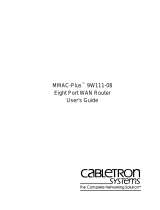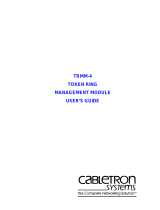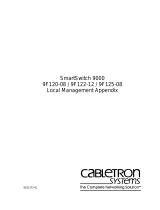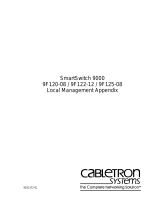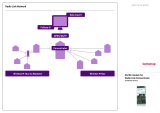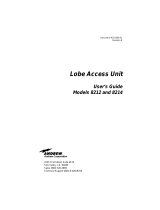Page is loading ...

CABLETRON SYSTEMS, P. O. Box 5005 Rochester, NH 03866-5005
The Complete Networking Solution
™
TRXMIM
TM
USER’S
GUIDE
MODELS 22A, 24A, 42A, 44A

NOTICE
i
NOTICE
Cabletron Systems reserves the right to make changes in specifications
and other information contained in this document without prior notice.
The reader should in all cases consult Cabletron Systems to determine
whether any such changes have been made.
The hardware, firmware, or software described in this manual is
subject to change without notice.
IN NO EVENT SHALL CABLETRON SYSTEMS BE LIABLE FOR
ANY INCIDENTAL, INDIRECT, SPECIAL, OR CONSEQUENTIAL
DAMAGES WHATSOEVER (INCLUDING BUT NOT LIMITED TO
LOST PROFITS) ARISING OUT OF OR RELATED TO THIS
MANUAL OR THE INFORMATION CONTAINED IN IT, EVEN IF
CABLETRON SYSTEMS HAS BEEN ADVISED OF, KNOWN, OR
SHOULD HAVE KNOWN, THE POSSIBILITY OF SUCH DAMAGES.
© Copyright February, 1996 by:
Cabletron Systems, Inc.
P.O. Box 5005, Rochester, NH 03866-0505
All Rights Reserved
Printed in the United States of America
Part Number 9031265 February, 1996
TRXMIM, TRBMIM, TDRMIM, TRMIM
,
TRMM-2
, and
TRMM-4
are trademarks of Cabletron Systems, Inc.
SPECTRUM
,
LANVIEW
, and
Remote LANVIEW
are registered
trademarks of Cabletron Systems, Inc.
IBM
is a registered trademark of International Business Machines
Corporation.
DEC
,
VT200
, and
VT300
are trademarks of Digital Equipment
Corporation.
CompuServe
is a trademark of CompuServe, Inc.
Printed On
Recycled Pape
r

FCC NOTICE
ii
FCC NOTICE
This device complies with Part 15 of the FCC rules. Operation is
subject to the following two conditions: (1) this device may not cause
harmful interference, and (2) this device must accept any interference
received, including interference that may cause undesired operation.
NOTE: This equipment has been tested and found to comply with the
limits for a Class A digital device, pursuant to Part 15 of the FCC rules.
These limits are designed to provide reasonable protection against
harmful interference when the equipment is operated in a commercial
environment. This equipment uses, generates, and can radiate radio
frequency energy and if not installed in accordance with the operator’s
manual, may cause harmful interference to radio communications.
Operation of this equipment in a residential area is likely to cause
interference in which case the user will be required to correct the
interference at his own expense.
WARNING: Changes or modifications made to this device which are
not expressly approved by the party responsible for compliance could
void the user’s authority to operate the equipment.
DOC NOTICE
This digital apparatus does not exceed the Class A limits for radio noise
emissions from digital apparatus set out in the Radio Interference
Regulations of the Canadian Department of Communications.
Le présent appareil numérique n’émet pas de bruits radioélectriques
dépassant les limites applicables aux appareils numériques de la class
A prescrites dans le Règlement sur le brouillage radioélectrique édicté
par le ministère des Communications du Canada.

CABLETRON SYSTEMS, INC. PROGRAM LICENSE AGREEMENT
iii
CABLETRON SYSTEMS, INC. PROGRAM LICENSE AGREEMENT
IMPORTANT: Before utilizing this product, carefully read this
License Agreement.
This document is an agreement between you, the end user, and
Cabletron Systems, Inc. (“Cabletron”) that sets forth your rights and
obligations with respect to the Cabletron software program (the
“Program”) contained in this package. The Program may be contained
in firmware, chips or other media. BY UTILIZING THE ENCLOSED
PRODUCT, YOU ARE AGREEING TO BECOME BOUND BY THE
TERMS OF THIS AGREEMENT, WHICH INCLUDES THE
LICENSE AND THE LIMITATION OF WARRANTY AND
DISCLAIMER OF LIABILITY. IF YOU DO NOT AGREE TO THE
TERMS OF THIS AGREEMENT, PROMPTLY RETURN THE
UNUSED PRODUCT TO THE PLACE OF PURCHASE FOR A FULL
REFUND.
CABLETRON SOFTWARE PROGRAM LICENSE
1. LICENSE. You have the right to use only the one (1) copy of the Program provided
in this package subject to the terms and conditions of this License Agreement.
You may not copy, reproduce or transmit any part of the Program except as
permitted by the Copyright Act of the United States or as authorized in writing by
Cabletron.
2. OTHER RESTRICTIONS. You may not reverse engineer, decompile, or
disassemble the Program.
3. APPLICABLE LAW. This License Agreement shall be interpreted and governed
under the laws and in the state and federal courts of New Hampshire. You accept
the personal jurisdiction and venue of the New Hampshire courts.

EXCLUSION OF WARRANTY AND DISCLAIMER OF LIABILITY
iv
EXCLUSION OF WARRANTY AND DISCLAIMER OF LIABILITY
1. EXCLUSION OF WARRANTY. Except as may be specifically provided by
Cabletron in writing, Cabletron makes no warranty, expressed or implied,
concerning the Program (including Its documentation and media).
CABLETRON DISCLAIMS ALL WARRANTIES, OTHER THAN THOSE
SUPPLIED TO YOU BY CABLETRON IN WRITING, EITHER EXPRESS OR
IMPLIED, INCLUDING BUT NOT LIMITED TO IMPLIED WARRANTIES OF
MERCHANTABLITY AND FITNESS FOR A PARTICULAR PURPOSE, WITH
RESPECT TO THE PROGRAM, THE ACCOMPANYING WRITTEN MATERIALS,
AND ANY ACCOMPANYING HARDWARE.
2. NO LIABILITY FOR CONSEQUENTIAL DAMAGES. IN NO EVENT SHALL
CABLETRON OR ITS SUPPLIERS BE LIABLE FOR ANY DAMAGES
WHATSOEVER (INCLUDING, WITHOUT LIMITATION, DAMAGES FOR LOSS
OF BUSINESS, PROFITS, BUSINESS INTERRUPTION, LOSS OF BUSINESS
INFORMATION, SPECIAL, INCIDENTAL, CONSEQUENTIAL, OR RELIANCE
DAMAGES, OR OTHER LOSS) ARISING OUT OF THE USE OR INABILITY TO
USE THIS CABLETRON PRODUCT, EVEN IF CABLETRON HAS BEEN
ADVISED OF THE POSSIBILITY OF SUCH DAMAGES. BECAUSE SOME
STATES DO NOT ALLOW THE EXCLUSION OR LIMITATION OF LIABILITY
FOR CONSEQUENTIAL OR INCIDENTAL DAMAGES, OR ON THE DURATION
OR LIMITATION OF IMPLIED WARRANTEES IN SOME INSTANCES THE
ABOVE LIMITATIONS AND EXCLUSIONS MAY NOT APPLY TO YOU.
UNITED STATES GOVERNMENT RESTRICTED RIGHTS
The enclosed product (a) was developed solely at private expense; (b)
contains “restricted computer software” submitted with restricted
rights in accordance with Section 52227-19 (a) through (d) of the
Commercial Computer Software - Restricted Rights Clause and its
successors, and (c) in all respects is proprietary data belonging to
Cabletron and/or its suppliers.
For Department of Defense units, the product is licensed with
“Restricted Rights” as defined in the DoD Supplement to the Federal
Acquisition Regulations, Section 52.227-7013 (c) (1) (ii) and its
successors, and use, duplication, disclosure by the Government is
subject to restrictions as set forth in subparagraph (c) (1) (ii) of the
Rights in Technical Data and Computer Software clause at 252.227-
7013. Cabletron Systems, Inc., 35 Industrial Way. Rochester, New
Hampshire 03867

CONTENTS
v
CONTENTS
CHAPTER 1 INTRODUCTION
1.1 USING THIS MANUAL . . . . . . . . . . . . . . . . . . . . . . . . . .1-2
1.2 ABOUT THE TRXMIM FAMILY . . . . . . . . . . . . . . . . . .1-2
1.2.1 TCU Ports . . . . . . . . . . . . . . . . . . . . . . . . . . . . . . . .1-3
1.2.2 Port Assignments and Port Switching. . . . . . . . . . .1-4
1.2.3 Automatic Configuration at Power-Up. . . . . . . . . .1-7
1.2.4 Support for Passive MAU Workgroups . . . . . . . . .1-8
1.2.5 Interaction with Other MIMs in the MMAC . . . .1-10
1.2.6 LANVIEW LEDs . . . . . . . . . . . . . . . . . . . . . . . . .1-11
1.2.7 Network Management. . . . . . . . . . . . . . . . . . . . . .1-11
1.3 FURTHER INFORMATION . . . . . . . . . . . . . . . . . . . . . .1-12
1.3.1 Related Manuals . . . . . . . . . . . . . . . . . . . . . . . . . .1-12
1.3.2 Recommended Reading . . . . . . . . . . . . . . . . . . . .1-12
1.3.3 Getting Help . . . . . . . . . . . . . . . . . . . . . . . . . . . . .1-13
CHAPTER 2 INSTALLATION REQUIREMENTS &
SPECIFICATIONS OF OPERATION
2.1 GENERAL CABLING CONSIDERATIONS . . . . . . . . . .2-1
2.1.1 Network Performance Requirements . . . . . . . . . . .2-1
2.1.2 Installation Recommendations . . . . . . . . . . . . . . . .2-2
2.1.3 Maximum Number of Stations . . . . . . . . . . . . . . . .2-3
2.2 UTP CABLING SPECIFICATIONS . . . . . . . . . . . . . . . . .2-3
2.2.1 UTP Cable Categories. . . . . . . . . . . . . . . . . . . . . . .2-4
2.2.2 UTP Cable Lengths to Stations. . . . . . . . . . . . . . . .2-5
2.3 STP CABLING SPECIFICATIONS . . . . . . . . . . . . . . . . .2-6
2.3.1 STP Cable Categories. . . . . . . . . . . . . . . . . . . . . . .2-6
2.3.2 STP Cable Lengths to Stations . . . . . . . . . . . . . . . .2-7
2.4 TRXMIM OPERATING SPECIFICATIONS . . . . . . . . . .2-8
2.4.1 Media Filters. . . . . . . . . . . . . . . . . . . . . . . . . . . . . .2-8
2.4.2 Connector Types. . . . . . . . . . . . . . . . . . . . . . . . . . .2-8

CONTENTS
vi
2.4.3 Ring Speeds . . . . . . . . . . . . . . . . . . . . . . . . . . . . . .2-9
2.4.4 Ring Sequence . . . . . . . . . . . . . . . . . . . . . . . . . . .2-10
2.4.5 LANVIEW LEDs . . . . . . . . . . . . . . . . . . . . . . . . .2-10
2.5 OTHER SPECIFICATIONS . . . . . . . . . . . . . . . . . . . . . .2-11
2.5.1 Hardware Specifications. . . . . . . . . . . . . . . . . . . .2-11
2.5.2 Environmental Requirements . . . . . . . . . . . . . . . .2-11
2.5.3 Safety Issues . . . . . . . . . . . . . . . . . . . . . . . . . . . . .2-11
2.5.4 Service Projections . . . . . . . . . . . . . . . . . . . . . . . .2-12
CHAPTER 3 INSTALLING THE TRXMIM
3.1 GENERAL CONSIDERATIONS . . . . . . . . . . . . . . . . . . .3-1
3.2 INSTALLATION . . . . . . . . . . . . . . . . . . . . . . . . . . . . . . . .3-2
3.2.1 Unpacking the TRXMIM . . . . . . . . . . . . . . . . . . . .3-2
3.2.2 Setting the Default Ring Speed Jumper . . . . . . . . .3-3
3.2.3 Installing the TRXMIM into an MMAC . . . . . . . .3-4
3.2.4 Boot-Up Check . . . . . . . . . . . . . . . . . . . . . . . . . . . .3-5
3.2.5 Connecting Lobe Cabling. . . . . . . . . . . . . . . . . . . .3-6
3.2.6 Pre-Operational Testing . . . . . . . . . . . . . . . . . . . . .3-9
CHAPTER 4 TESTING AND TROUBLESHOOTING
4.1 INSTALLATION CHECKOUT. . . . . . . . . . . . . . . . . . . . .4-1
4.2 LANVIEW LED SIGNALS. . . . . . . . . . . . . . . . . . . . . . . .4-2
4.2.1 LANVIEW LED Definitions Table . . . . . . . . . . . .4-3
4.2.2 ERR - Error. . . . . . . . . . . . . . . . . . . . . . . . . . . . . . .4-4
4.2.3 BYP - Bypass . . . . . . . . . . . . . . . . . . . . . . . . . . . . .4-4
4.2.4 MGMT - Management Mode . . . . . . . . . . . . . . . . .4-5
4.2.5 16MB - Ring Speed . . . . . . . . . . . . . . . . . . . . . . . .4-5
4.2.6 IN USE - Ring In Use. . . . . . . . . . . . . . . . . . . . . . .4-6
4.2.7 PORT - Port Status . . . . . . . . . . . . . . . . . . . . . . . . .4-7

CONTENTS
vii
APPENDIX A INTRODUCTION TO FOUR-RING
FNB FUNCTIONALITY
A.1 Introduction. . . . . . . . . . . . . . . . . . . . . . . . . . . . . . . . . . . . A-1
A.2 The Flexible Network Bus (FNB). . . . . . . . . . . . . . . . . . . A-1
A.3 FNB Operations Without Port Switching. . . . . . . . . . . . . A-1
A.4 FNB Operations With Port Switching . . . . . . . . . . . . . . . A-3
A.5 Configuration Specifications . . . . . . . . . . . . . . . . . . . . . . A-5

Page 1-1
CHAPTER 1
INTRODUCTION
Welcome to the
Token Ring Port Switching Media Interface
Modules User’s Guide
. This manual serves as a reference for the
installation and troubleshooting of Cabletron Systems modules
TRXMIM-22A™, TRXMIM-24A™, TRXMIM-42A™, and
TRXMIM-44A™.
The TRXMIM models -22A / -24A / -42A / -44A, shown in Figure
1-1, comprise a family of active UTP/STP concentrators with port
switching capability for Token Ring networks. All four models are
designed for installation into any Cabletron Systems Multi Media
Access Center
®
(MMAC™) equipped with a Flexible Network Bus
®
(FNB™). All four TRXMIMs are IEEE 802.5 compliant and IBM
compatible.
Figure 1-1. The TRXMIM-22A, TRXMIM-24A, TRXMIM-42A, and
TRXMIM-44A Token Ring Port Switching Concentrator Modules.
TRXMIM-22A
SWITCHING UTP
TOKEN RING
126
115
104
93
82
71
IN USEAUX2-16Mb
AUX1-16Mb
RING4-16Mb
RING3-16Mb
RING2-16Mb
RING1-16Mb
BYP
IN USE
IN USE
IN USE
IN USE
IN USE
MGNT
ERR
-PORTS-
TRXMIM-24A
SWITCHING UTP
TOKEN RING
126
115
104
93
82
71
IN USEAUX2-16Mb
AUX1-16Mb
RING4-16Mb
RING3-16Mb
RING2-16Mb
RING1-16Mb
BYP
IN USE
IN USE
IN USE
IN USE
MGNT
ERR
-PORTS-
24
23
22
21
20
19
18
17
16
15
14
13
IN USE
TRXMIM-42A
126
115
104
93
82
71
IN USEAUX2-16Mb
AUX1-16Mb
RING4-16Mb
RING3-16Mb
RING2-16Mb
RING1-16Mb
BYP
IN USE
IN USE
IN USE
IN USE
IN USE
MGNT
ERR
-PORTS-
SWITCHING STP
TOKEN RING
TRXMIM-44A
SWITCHING STP
TOKEN RING
126
115
104
93
82
71
IN USEAUX2-16Mb
AUX1-16Mb
RING4-16Mb
RING3-16Mb
RING2-16Mb
RING1-16Mb
BYP
IN USE
IN USE
IN USE
IN USE
MGNT
ERR
-PORTS-
24
23
22
21
20
19
18
17
16
15
14
13
IN USE
1
X
2
X
3
X
5
X
4
X
6
X
7
X
8
X
9
X
10
X
11
X
12
X
13
X
14
X
15
X
16
X
17
X
18
X
19
X
20
X
21
X
22
X
23
X
24
X
1
X
2
X
3
X
5
X
4
X
6
X
7
X
8
X
9
X
10
X
11
X
12
X
13
X
14
X
15
X
16
X
17
X
18
X
19
X
20
X
21
X
22
X
23
X
24
X
1
X
2
X
3
X
5
X
4
X
6
X
7
X
8
X
9
X
10
X
11
X
12
X
1
X
2
X
3
X
5
X
4
X
6
X
7
X
8
X
9
X
10
X
11
X
12
X

USING THIS MANUAL
Page 1-2
1.1 USING THIS MANUAL
Prior to installing and operating the TRXMIM, please read through
this manual completely to become familiar with its contents and
with the features of the TRXMIM. If you are not familiar with port
switching and four-ring FNB applications, please begin by reading
Appendix A,
Introduction to Four-Ring FNB Functionality
.
A
general working knowledge of Token Ring (IEEE 802.5) networks is
helpful during installation.
Chapter 1,
Introduction
, describes how to use this document,
provides an overview of the features and capabilities of each
concentrator module, and concludes with a list of related manuals.
Chapter 2,
Installation Requirements & Specifications
, lists the
network requirements that must be met before installation, and
provides detailed specifications for each TRXMIM model.
Chapter 3,
Installing the TRXMIM
, contains instructions for
installing the TRXMIM into a Multi Media Access Center
®
(MMAC™) and attaching Token Ring station cabling.
Chapter 4,
Testing and Troubleshooting
, describes diagnostic
checks to assist in the correction of post-installation problems, and
provides detailed descriptions of LANVIEW
®
, Cabletron Systems’
built-in visual diagnostic and status monitoring system.
Appendix A,
Introduction to Four-Ring FNB Functionality,
discusses the concepts of port switching and port assignment.
1.2 ABOUT THE TRXMIM FAMILY
The TRXMIM family of concentrator modules provides MMAC
users with a new level of network connectivity. Their port
switching ability (fully described in Section 1.2.2,
Port
Assignments and Port Switching
) expands the number Token
Rings available within an MMAC and enables MMAC users to
switch ring connections between up to six Token Rings, without
changing a single cable connection. TRXMIMs also offer:
• complete compatibility with all Token Ring MIMs,

TCU Ports
Page 1-3
• support for Cabletron Systems’ Automatic Beacon Recovery
Process (ABRP),
• automatic speed fault protection,
• active filtering, re-timing, and repeating circuitry on all ports,
• Multiple Ring Out connectivity for Passive MAU workgroups,
• and LANVIEW LEDs for “at-a-glance” diagnostic monitoring.
Note:
The TRXMIM only
executes
port switching. Port-switching
assignments must be issued by a management module
with
port-assigning capability, such as TRMM-2 or TRMM-4.
1.2.1 TCU Ports
Each TRXMIM is equipped with 12 or 24 TCU (Trunk Connector
Unit) ports, depending on the TRXMIM model (see Table 1-1). Each
TCU port is fitted with a female RJ-45 modular connector jack to
support the attachment of either STP (shielded twisted pair) or UTP
(unshielded twisted pair) cabling with RJ-45 connector plugs.
Models that support STP cabling use RJ-45 connectors that provide
a grounded connection for the cabling shield.
Lobe Port and Ring Out Port Configurations
Each TCU port on the TRXMIM is internally defaulted to operate as
a lobe interface to support the insertion of a Token Ring station into
a ring. However, each TCU port may also be reconfigured, via the
Local Management (LM) application, to function as a Ring Out port
to support the connection of passive MAU (Multi-Station Access
Table 1-1 Port and Media List for TRXMIM Models
TRXMIM-22A 12 - Unshielded RJ-45 ports
TRXMIM-24A 24 - Unshielded RJ-45 ports
TRXMIM-42A 12 - Shielded RJ-45 ports
TRXMIM-44A 24 - Shielded RJ-45 ports

ABOUT THE TRXMIM FAMILY
Page 1-4
Unit) workgroups. See Section 1.2.4,
Support for Passive MAU
Workgroups
.
Active Circuitry
On each TCU port, TRXMIMs provide active circuitry which filters,
equalizes, and amplifies all received signals before transmitting
them to the next point on the ring. The result is enhanced signal
integrity and extended maximum station lobe cable distances.
Ring Speed Fault Protection
TRXMIMs also provide Ring Speed Fault Protection on each TCU
port to protect against beaconing conditions caused by stations
inserted at the wrong ring speed. The TRXMIM checks the ring
speeds of both the inserting station and the destination ring; if there
is a mismatch, the TRXMIM disables the port to keep the
misconfigured station isolated from the ring. The TRXMIM then
provides a simple visible LED signal to indicate to network
managers that Speed Fault Protection has disabled the port. The
port stays disabled until re-enabled by management. Refer to
Section 4.2,
LANVIEW LED SIGNALS
for information on the
LANVIEW LED visual status monitoring system.
1.2.2 Port Assignments and Port Switching
The TRXMIM requires the support of a port-assigning management
module (such as TRMM-2 or TRMM-4) to activate its port switching
functionality.
Without Port Switching
Without port-switching MIMs, MMAC users can create multiple
Token Ring LANs within an MMAC only by segmenting or
“wrapping” the FNB (as shown in Figure 1-2), and they can provide
access to only one ring segment from any one module. Thus, in
order to move a station from one ring to another, network
managers have to enter the wiring closet and physically move cable
connections from one module to another. With the advent of the

Port Assignments and Port Switching
Page 1-5
port-switching TRXMIM, Cabletron Systems offers alternative
solutions.
Figure 1-2. FNB ring 1 segmented to form two LANs
With Port Switching
When controlled by a management module which supports port
switching, TRXMIMs and other port switching MIMs make use of
additional pins in their FNB connectors to create three additional
vertically stacked FNB rings as shown in Figure 1-3. The FNB itself
does not change, but these modules change the way it is used.
Figure 1-3. FNB Expanded to Four Rings by Port Switching MIMs
TRXMIMs are thus able to offer flexible network connectivity,
eliminating the need to change cable connections when switching
TRMIM
TRMIM
TRMIM
TRMM
TRMIM
TRMIM
TRMIM
TRMMIM
FNB ring wrapped at TRMMIM's right FNB interface.
FNB ring
segment A
FNB ring
segment B
Port-Switching MIMs
FNB ring 1
FNB ring 2
FNB ring 3
FNB ring 4
TRMM-4
TRXMIM
TRXMIM
TRXMIM
TRXMIM
TRXMIM
TDRMIM
TDRMIM

ABOUT THE TRXMIM FAMILY
Page 1-6
stations from ring to ring. To move a station from one ring to
another, a user simply accesses the Local Management application
and issues a new port assignment. The TRXMIM then switches the
TCU’s port-to-ring connection internally, as illustrated in Figure
1-4, instantly connecting the station to the new ring.
Figure 1-4. Logical Model of Port Assignment and Port Switching
Auxiliary Rings
The TRXMIM also hosts two internal auxiliary rings which exist
only within the circuits of the TRXMIM module. Although these
“module-level” auxiliary rings do not have access to the FNB, they
function as complete, independent Token Rings within the module.
This brings the connectivity total to six Token Rings accessible from
any TRXMIM port: two isolated auxiliary rings within the module
itself, and four rings on the FNB which can be used to
intercommunicate with other stations/devices connected to the
same FNB rings via other MIMs in the hub.
FNB ring 1
FNB ring 2
FNB ring 4
FNB ring 3
Port Assignments
made by Token Ring Management Module
are executed internally by TRXMIM.
Electronic reassignment of Port 12 from Ring 2 to Ring
4
TRXMIM-22A
SWITCHING UTP
TOKEN RING
7
X
8
X
9
X
10
X
11
X
12
X
1
X
2
X
3
X
4
X
5
X
6
X
126
115
104
93
82
71
IN USEAUX2-16Mb
AUX1-16Mb
RING4-16Mb
RING3-16Mb
RING2-16Mb
RING1-16Mb
BYP
IN USE
IN USE
IN USE
IN USE
IN USE
MGNT
ERR
-PORTS-

Automatic Configuration at Power-Up
Page 1-7
1.2.3 Automatic Configuration at Power-Up
The management module in the TRXMIM’s host MMAC stores all
user-configured port assignments in its NVRAM. Upon hub
start-up or TRXMIM reset, the management module reissues its
stored configurations to the TRXMIM so that all port assignments
set before power-down are reinstated at next power-up.
Some management modules, including the TRMM-2, also have
hardware jumpers or a switchblock to hold default ring speed
settings which are issued to all modules in the absence of
user-defined configurations stored in NVRAM.
If the TRXMIM receives no management-issued configuration
information at start-up (i.e. configuration settings from a
management module’s NVRAM are not available), the device uses
the configurations dictated by its hardware default settings.
Assignments from a management module always override the
TRXMIM’s hardware defaults.
Default Port Assignments
All TRXMIM TCU ports are assigned by default to FNB ring 1. This
default is not user-configurable.
Default Ring Speeds
The FNB ring 1 default ring speed is set by the position of the
Default Ring Speed Jumper. See Section 3.2.2,
Setting the Default
Ring Speed Jumper
for configuration instructions.
The default ring speed setting for all other rings (FNB rings 2 - 4
and Auxiliary rings 1 & 2) is 16 Mb/s. This default is not
user-configurable.
Management module defaults or NVRAM settings for ring speeds
override all TRXMIM hardware default ring speed settings. (The
TRMM-2, for example, has a switchblock on which ring speeds are
defined for the entire hub.) Consult the management module’s
manual for instructions on setting ring speeds throughout the hub.

ABOUT THE TRXMIM FAMILY
Page 1-8
1.2.4 Support for Passive MAU Workgroups
Whereas a station signals a TCU to open its interface by sending a
phantom current down its lobe cable, a passive MAU can not
provide phantom current. A TCU Ring Out port is therefore
configured to ignore the absence of phantom current in the
connecting cable and to look instead for the presence of data bits to
determine link status.
By default, each of the TRXMIM’s TCU ports is configured to its
STN (station) setting to support concentrator lobe connections to
stations. Through Local Management, any TCU port may be
reconfigured to its RO (Ring Out) setting to support connections to
passive MAU (Multi-Station Access Unit) workgroups.
Note:
The output of the TRXMIM’s LANVIEW LEDs for a Ring Out
port is quite different from the output for a station lobe port. See Section
4.2,
LANVIEW LED SIGNALS
, for a discussion of this and all other
LED signal details.
Improved Protection from Beaconing
The TRXMIM provides enhanced reliability for existing networks
which use passive MAUs because Multiple Ring Out TCUs allow
for the separate attachment of each MAU. Rather than
daisy-chaining MAUs together as a single entity and risking their
collective isolation in case of beaconing, the user can now attach
each MAU individually, reducing the number of MAU ports that
are at risk of collective isolation in case of beaconing on the ring; the
TRXMIM’s Beacon Recovery system may bypass individually
connected MAUs on an individual rather than collective basis. See
Figure 1-5.

Support for Passive MAU Workgroups
Page 1-9
Figure 1-5. Improved Beacon Recovery Resolution for MAUs
(8 Stations)
(8 Stations)
(8 Stations)
(8 Stations)
TRXMIM
Ring
Out
Ring
Out
Ring
Out
Ring
Out
Multi-Station
Access Units
Ring
In
Ring
In
Ring
In
Ring
In
When each MAU is individually connected to the TRXMIM,
only one MAU must be bypassed
to isolate the hub from a beaconing MAU station.
The 8 stations on that MAU still go down,
but the remaining MAUs and their stations stay operational.
(8 Stations)
(8 Stations)
(8 Stations)
(8 Stations)
Multi-Station
Access Units
MIM with
Ring In / Ring Out
Ring
Out
Ring
Out
Ring
Out
Ring
Out
Ring
In
Ring
In
Ring
In
Ring
In
Ring
Out
Ring
In
When MAUs are daisy-chained,
they are connected as single collective entity.
The entire chain must be bypassed
to isolate the hub from a single beaconing station.
All stations lose connection if beaconing occurs on any station.
COMMON MAU CONFIGURATION
TRXMIM MAU CONFIGURATION

ABOUT THE TRXMIM FAMILY
Page 1-10
No Connection Redundancy
The TRXMIM MAU configuration does not provide for the MAU’s
redundant connection to the ring. In the common configuration, a
MAU chain is dual-attached to the Token Ring LAN via both a Ring
Out cable and a Ring In cable. Using a TCU port, however, each
passive MAU workgroup is physically connected to the hub in the
same manner as a station—by a single cable—and therefore is not
provided a backup path between the MAU and the Token Ring
network.
Only the dual attachment of Ring In
and
Ring Out cables can
provide a backup path. This level of connectivity must be provided
by Token Ring Repeater MIMs (such as TRRMIM or TDRMIM)
which are designed to extend trunk connections with full
redundancy.
1.2.5 Interaction with Other MIMs in the MMAC
Multiple concentrator modules can be installed into an MMAC to
increase the number of ports available on a Token Ring network.
Any TRXMIM installed within an MMAC may be connected to
other Token Ring MIMs, repeaters, bridges, and management
modules within the hub. When installed contiguously in the
MMAC and configured with identical ring speed settings, port
switching MIMs automatically attach to each other via the
continuous FNB rings on the backplane. If, however, a
management module issues wrapping commands, the specified
neighboring MIMs will wrap at their FNB interfaces, breaking the
FNB ring connections between them, and effectively segmenting
the FNB.
Note:
If the MMAC has a shunting FNB, vacant hub slots do not cause
breaks in FNB rings: the shunting FNB connectors on the backplane
provide a bypass circuit, maintaining ring continuity across vacant slots.
If the MMAC does not have a shunting FNB, vacant slots will force the
FNB rings to wrap, segmenting the FNB rings.
When port switching MIMs are interconnected, so are the
additional FNB rings they have each created at their FNB interfaces.

LANVIEW LEDs
Page 1-11
Thus FNB rings 2, 3, and 4 are extended across the MMAC as far as
there are port switching modules to carry them. Port switching
MIMs are also compatible with earlier single-ring MIMs (e.g.
TRMIM) and will interconnect across FNB ring 1, but not across
FNB rings 2, 3, or 4. (Single-ring MIMs do not have port switching
capability and
cannot
support connections across FNB rings 2, 3, or
4.) For more explanation on four-ring FNB functionality, see
Appendix A,
Introduction to Four-Ring FNB Functionality
.
Note: It is recommended that all single-ring MIMs be grouped in
the left-most slots of the MMAC and all port switching MIMs be
grouped in the right-most slots
because any
single-ring MIM installed
between port switching MIMs will break the continuity of FNB rings 2, 3,
4; and management modules that have direct FNB interfaces to FNB rings
2, 3, and 4 require contiguous contact with other port switching MIMs to
maintain ring continuity.
1.2.6 LANVIEW LEDs
The LANVIEW LED system is Cabletron Systems’ built-in,
“at-a-glance,” visual diagnostic and status monitoring system
which facilitates the quick diagnosis of physical layer network
problems. The LANVIEW LED system comprises several LEDs,
located on the front panel of the TRXMIM, which light, blink, and
flash in various colors to indicate various network and
module-specific conditions. The LANVIEW LED signal system is
discussed in detail in Section 4.2, LANVIEW LED SIGNALS.
1.2.7 Network Management
With a management module installed in slot 1 of the MMAC, the
TRXMIM and other modules in the hub can be monitored and
controlled by a variety of network management tools including
Cabletron Systems Local Management, Remote LANVIEW
®
/
Windows, and SPECTRUM
®
. Any Token Ring management
module may be used to manage the TRXMIM, but only a module
that supports port switching can activate the port-switching
functionality of the TRXMIM.

FURTHER INFORMATION
Page 1-12
1.3 FURTHER INFORMATION
1.3.1 Related Manuals
The manuals listed below should be used to supplement the
procedures and other technical data provided in this manual. The
procedures in them will be referenced, where appropriate, but will
not be repeated.
Cabletron Systems TRMM-2 User’s Guide (PN 9031287)
Cabletron Systems TRMM-2 Local Management User’s Guide
(PN 9031389)
Cabletron Systems TDRMIM-22A/42A Token Ring Dual
Repeaters User’s Guide (PN 9031428)
1.3.2 Recommended Reading
The following publications are recommended if more information
is required regarding the implementation of Token Ring networks.
Local Area Networks, Token Ring Access Method, IEEE Standard
802.5 (1989)
Commercial Building Wiring Standard, EIA Standard Proposal
No. 1907-B (if approved, to be published as EIA/TIA-568)
LAN Troubleshooting Handbook, Mark Miller (1989, M&T
Publishing)
1.3.3 Getting Help
If you need additional support related to Cabletron Systems Token
Ring products, or if you have any questions, comments or
suggestions related to this manual, please contact Cabletron
Systems Technical Support:
By phone: (603) 332-9400
Monday-Friday; 8am - 8pm EST
/
